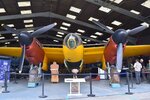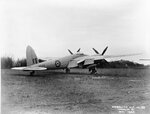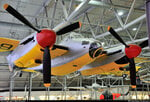The British air ministry forced De Havilland to install a turret in a mock up, but the speed reduction was significant, so it was droope
The first picture is the installation fitted to the prototype W4050, which was a mock up only for drag trials. Note the holes, through which dummy guns were poked to assess their effect on drag. The second is most likely W4053, the turret fighter prototype fitted with an actual Bristol B.11 turret. Again though, this work was for a dedicated turret equipped night fighter, not for the tail turret equipped bomber. The prototype still has the fittings for the turret buried in its fuselage. As mentioned, two turret fighters were produced, these eventually became the prototypes of the T.III, the third flying prototype W4053 and W4073 and the turret fighter was canned, also because the B.11 turret would not rotate at speed. It's hydraulic system was not up to task.
At the time the first turret fighter Mossie flew, DH had produced the fixed gun night fighter prototype, W4052 and that proved faster, naturally and the decision was made to not progress with the turret fighter variant as a result of the manufacturer's findings regarding the turret not moving at speed. The second turret fighter went from the production line straight to having the turret removed.
Last edited:



